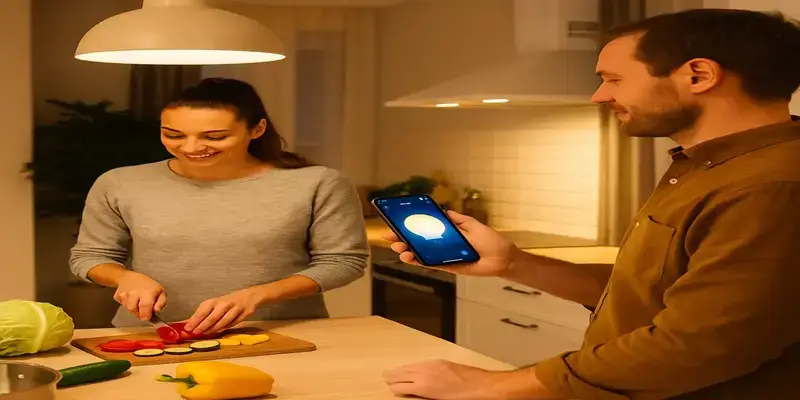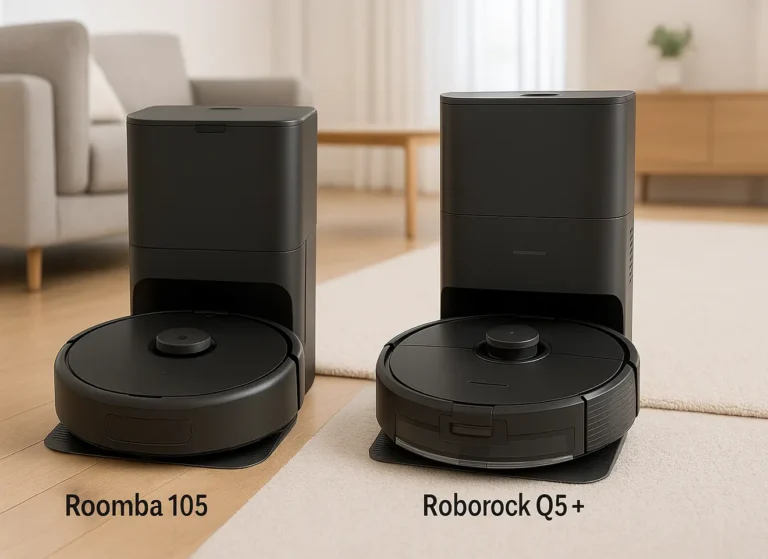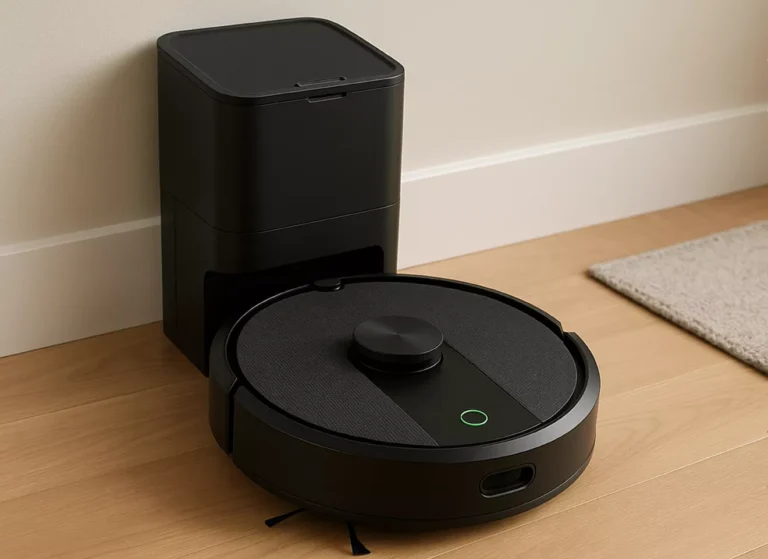Roomba 104 vs 105 — The Hidden Differences That Actually Matter
Both are modern, smart-mapping Roombas you can schedule from the app. Roomba 104 is the simplest, vacuum-only, charge-only option and the most affordable way into this generation. Roomba 105 is a flexible family (Vac or Combo) and can be bought in AutoEmpty bundles for less hands-on maintenance. This roomba 104 vs 105 guide highlights the real-world differences so you can choose fast.
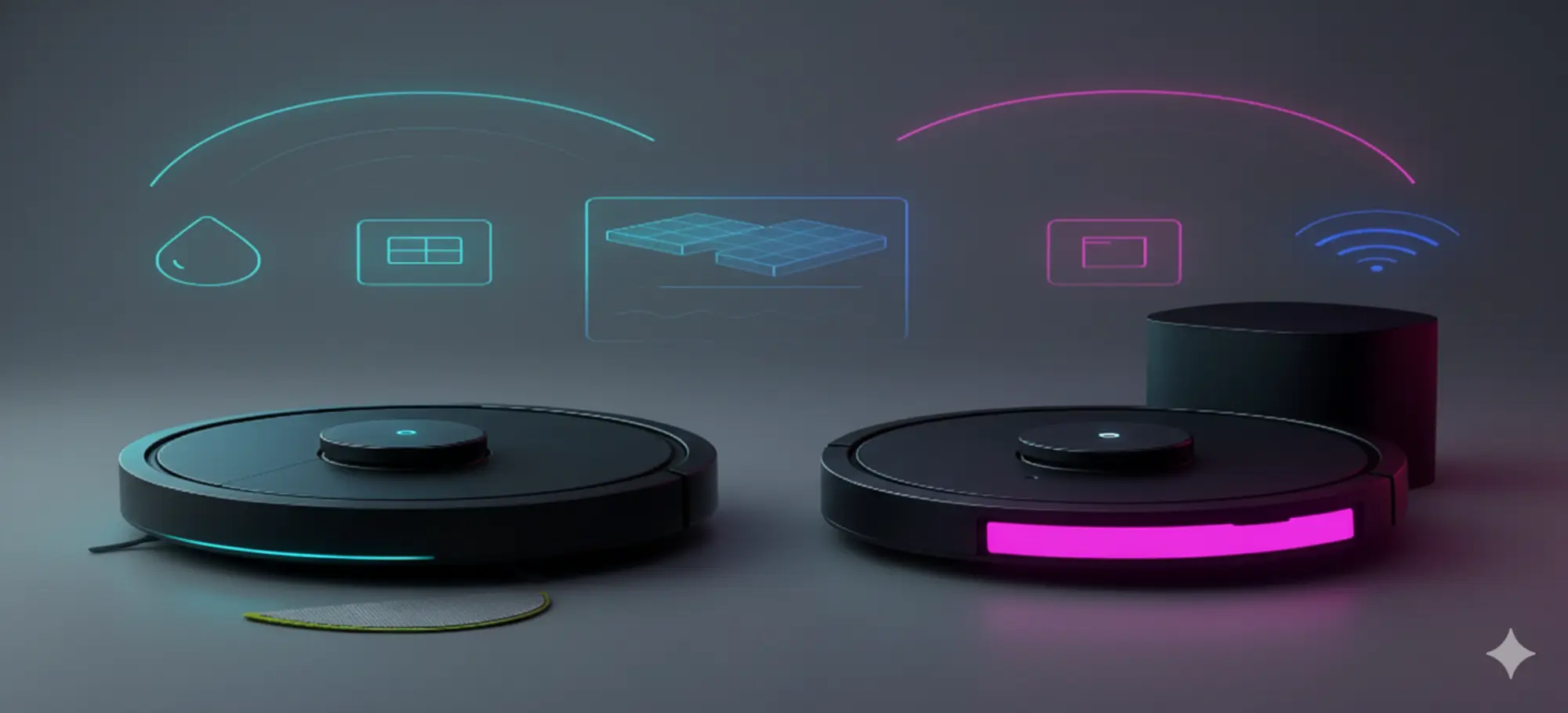
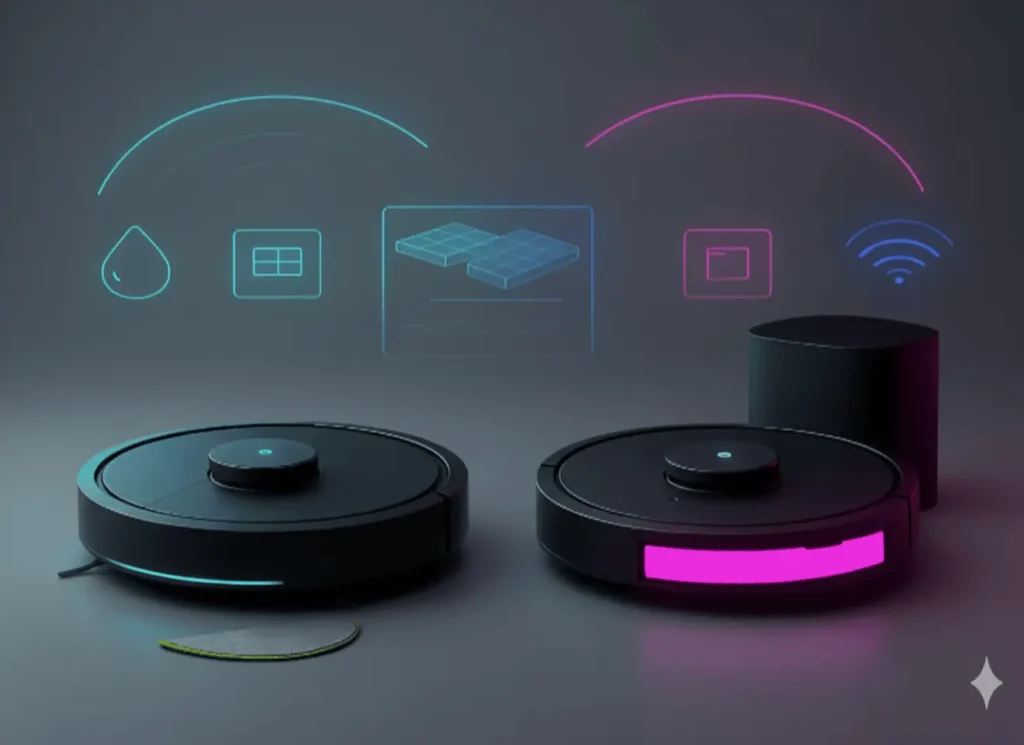
This image has been generated using AI for illustrative purposes only and does not represent an actual product image.
Getting to Know Roomba 104 and 105: What You Need First
The 100-series focuses on predictable cleaning over gimmicks. You press Clean, the robot maps, and it follows tidy, systematic routes instead of random zigzags. The 104 and 105 share that brain but not the same “lifestyle” options.
They target everyday messes: crumbs, dust film, pet hair tumbleweeds, and light grit from doorways. The 104 keeps things minimal: vacuum only, charge-only dock, straightforward setup. The 105 expands into a small family with a Vac version, a Combo (vac+mop) version, and bundles that include an AutoEmpty dock for fewer bin trips.
A helpful mental model: think in tiers of convenience. The 104 is “do the basics right.” The 105 is “do the basics, then add conveniences when you want them.” Neither aims to be a premium showpiece; both aim to be appliances you forget about until floors look dusty again.
Main Features That Define Daily Use
Navigation & Mapping
Both lines learn your layout and improve coverage across the first few runs. You’ll name rooms in the app, send the robot to clean specific areas, and watch row-by-row passes settle into a consistent pattern. The practical gain is fewer missed strips, cleaner edges, and easier week-to-week predictability.
Map setup and refinement
The first two or three runs matter. Keep doors in their typical, everyday positions and remove cable nests. If a doorway was blocked on day one, a follow-up room-only run helps the map “notice” that space and integrate it into regular routines.
Selective room cleans
Once rooms are labeled, quick targeted cleans become routine: kitchen after dinner, entryway after a muddy walk, or office after a craft project. It’s the most time-saving trick in the app because it replaces a full-home pass with a 10-minute tidy-up.
Suction & Cleaning Modes
Treat suction messaging as a class indicator, not a lab metric. On sealed floors and low-pile rugs, pickup is steady and repeatable. Spot mode helps when a single spill happens, and an edge pass tidies dust lines along baseboards. The headline here is not “numbers,” but consistency you can count on daily.
Edge, corner, and wall passes
Side brushes flick debris into the intake path; the robot’s route gets close to the wall, then tracks along it. In tight L-shaped corners, a second pass after clutter is moved can finish what the first pass missed.
Spill recovery (spot mode)
For coffee grounds, cereal bursts, or potting soil, a small spiral pattern in spot mode usually restores the area. It’s faster than scheduling a whole-home clean and preserves battery for the tasks that matter.
Battery & Runtime
Smaller homes often finish in a single pass. Larger or more cluttered layouts may split a job into two sessions: clean, recharge, resume. Shorter, frequent schedules prevent buildup, keep noise predictable, and make every clean feel quicker. Reliability matters more than a theoretical minute count.
Scheduling that actually works
Weekdays: short, room-targeted runs when traffic is predictable. Weekends: a full-home reset when you’re out. If the robot runs when nobody is around, perceived noise drops and maps tend to remain more stable.
Dock placement
Leave a clean lane in front of the dock and a little breathing room on both sides. Crooked approaches cause tiny alignment hiccups that snowball into retries. A neat approach equals clean docking equals fewer interruptions.

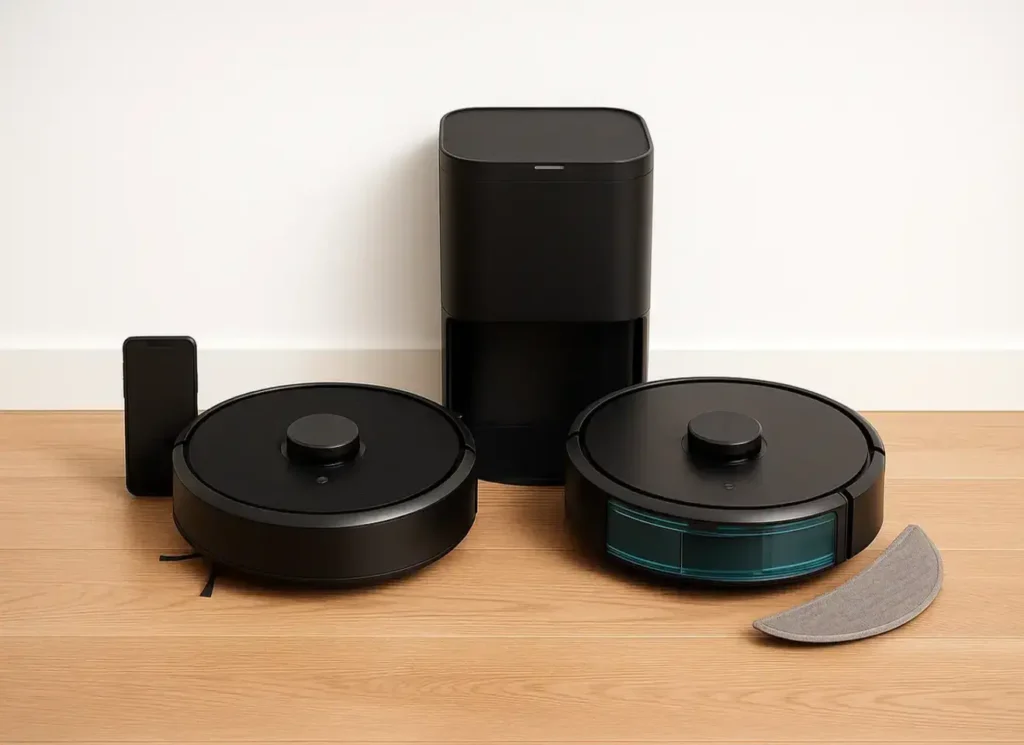
This image has been generated using AI for illustrative purposes only and does not represent an actual product image.
App Controls & Voice Assistants
Maps, schedules, selective room cleans, and maintenance reminders live inside the iRobot Home app. Voice control handles hands-free starts and quick room calls. Useful routine: a short kitchen run after dinner and a whole-home run on weekend mornings.
Maintenance reminders
The app pings you when filters clog, side brushes fray, or the main brush needs attention. Treat reminders as nudges, not alarms: if performance looks fine, check at the next prompt. If pickup feels weaker, check now.
Profiles and routines
Store multiple routines—“morning tidy,” “after-dinner,” “weekend reset.” Over time, these routines matter more than any single spec because they turn cleaning into a background habit.
Maintenance & Consumables
Filters, a side brush, and the main brush make up routine care. Empty the bin, tap out the filter, and check for hair wrap after heavy shed weeks. The Roomba 105 can be purchased in AutoEmpty bundles, which shift your effort from daily bin trips to occasional bag swaps. If you choose 105 Combo, you add a pad and a small water reservoir—still simple, but it is extra upkeep.
Hair management
Long hair winds around the main brush first; pet undercoat tends to clog the filter. Five minutes with scissors and a quick filter tap once a week keeps suction consistent. It’s the cheapest performance unlock there is.
Parts lifecycle
Side brushes fray first, then filters clog, then the main brush shows wear. When you start seeing dust trails after a pass, suspect airflow (filter) before blaming navigation.
Noise & Build Feel
Expect an honest sound profile for the class and a chassis meant for routine taps. You’ll notice it during a quiet call in the same room; in normal household hum, it blends. Bumpers and plastics are designed for daily life, not glass-shelf delicacy.
What “everyday durability” looks like
A robot that shrugs off chair-leg taps and sofa-edge nudges is doing its job. Door thresholds and floor transitions are shared enemies of every robot; if a lip is tall, a hand-smooth or rug gripper makes the map behave.
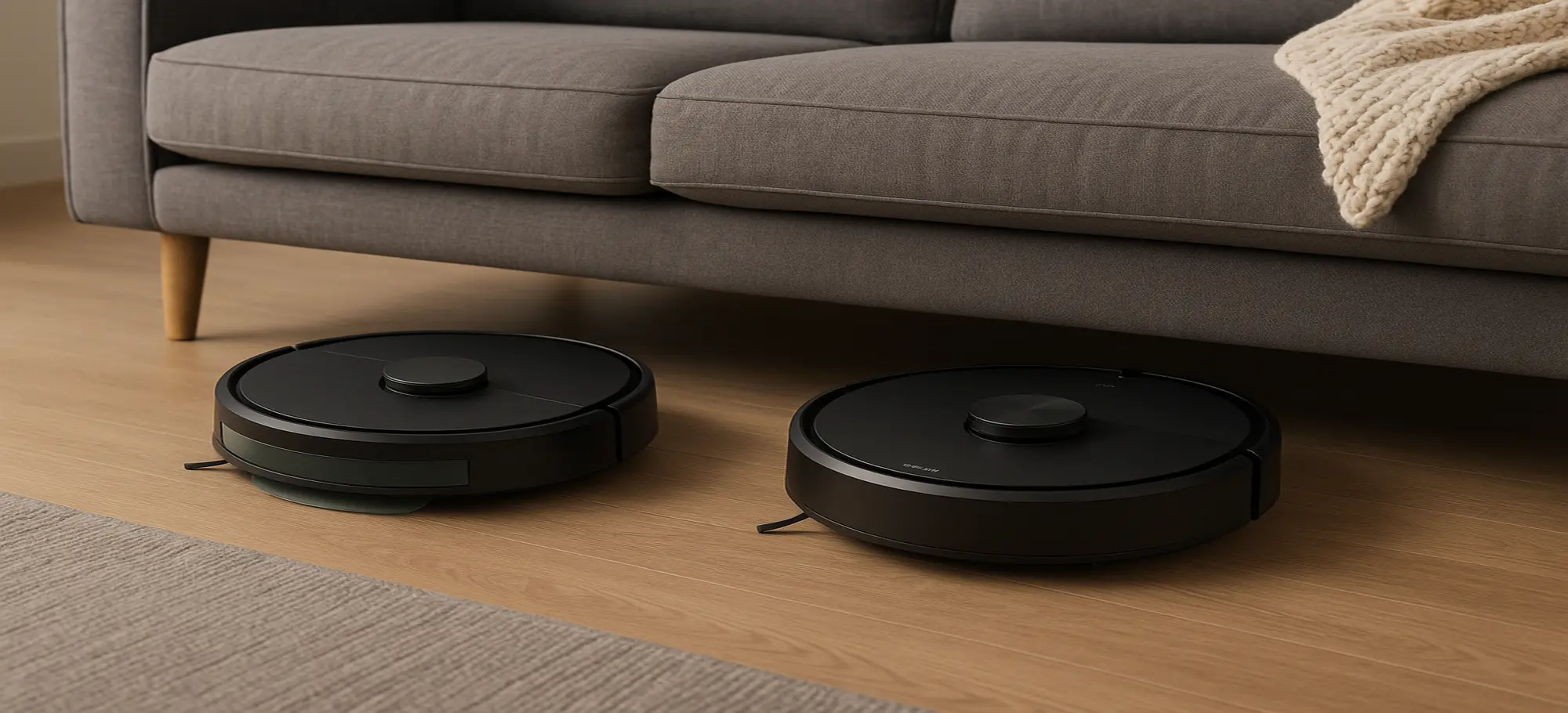
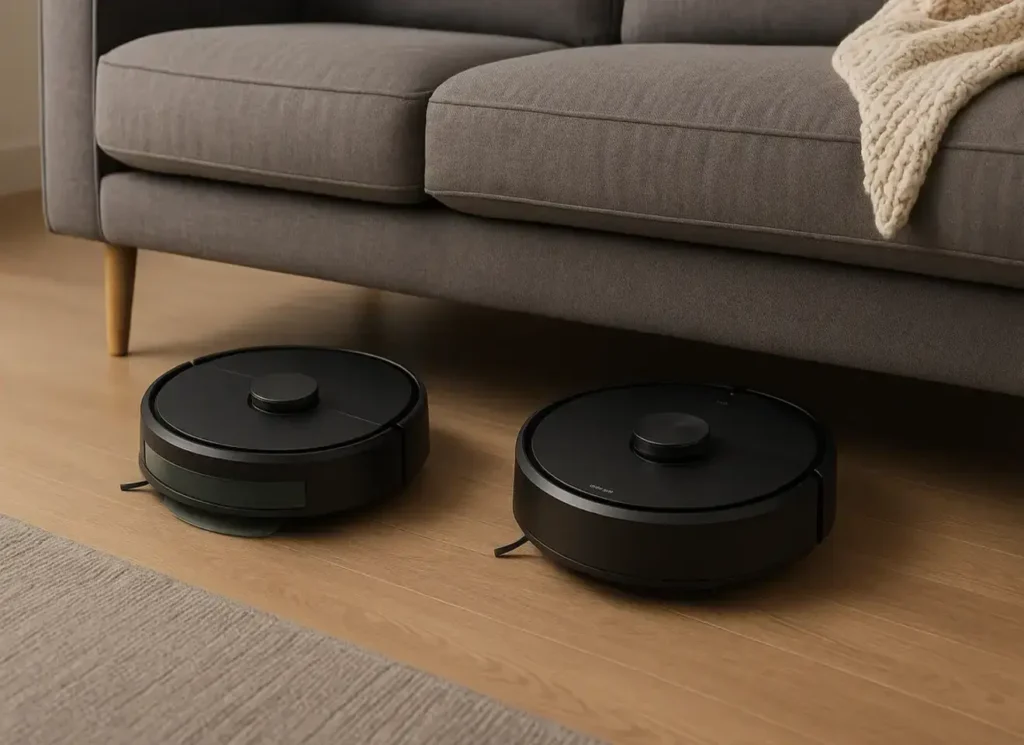
This image has been generated using AI for illustrative purposes only and does not represent an actual product image.
Key Differences (the ones you’ll actually notice)
Cleaning type: 104 is vacuum-only. 105 adds a Combo variant for light mopping on sealed floors.
AutoEmpty: 104 (charge-only) doesn’t ship with AutoEmpty; 105 can be bought in AutoEmpty bundles that reduce bin chores.
Family breadth: 105 comes in more configurations, so it’s easier to match to your home today and adjust later without switching series.
Convenience bias: 104 favors simplicity; 105 favors choice. If you might want more hands-off cleaning later, 105 is the safer bet.
Who Should Buy Which
Pick the Roomba 104 if your priority is lowest cost with modern mapping and you don’t need mopping or auto-emptying. It’s a dependable vacuum that keeps daily debris in check without adding maintenance tasks you won’t use.
Pick the Roomba 105 if you want choice: Vac now, Combo for hard-floor shine, and AutoEmpty to minimize hands-on maintenance. It’s a platform you can grow into rather than replace.
Real-World Tests (what matters when you hit “Clean”)
Hard floors: Both track in neat rows and collect fine dust that mops smear around. A second edge pass catches leftover hairline dust along baseboards.
Low-pile rugs: Expect good pickup and straight tracks. If a rug corner flips up and causes a bump-back, smooth the edge once—maps adapt quickly after that.
Door thresholds: Typical transitions are fine; taller lips sometimes need a nudge. Position the dock so the robot approaches its lane straight to reduce small misalignments over time.
Cable zones: Cords are every robot’s nemesis. Mark a small no-go zone in the app or lift the nest into a basket. The five seconds you spend pre-pass saves the five minutes you’d spend detangling later.
Hair weeks: Brush checks keep suction stable. If pickup drops after a pet-shed day, it’s almost always the filter or brush—not navigation—asking for attention.
Floor types in more detail
Tile and sealed hardwood: Both models excel at collecting micro-dust and crumbs that otherwise require a broom. If a grout line traps grit, run a second short pass on a perpendicular route; the different approach angle helps.
Laminate and vinyl: Footprint smears vanish quickly with a simple vacuum pass. If you choose the 105 Combo, a quick damp pass after vacuuming keeps the “just cleaned” look longer.
Medium-pile rugs: Expect decent results with two passes. If tracks look uneven, rotate the rug or smooth a curled edge; tiny geometry changes reduce snag points and improve consistency over time.
Rug fringe and tassels: Avoided best by no-go zones. If a tassel catches once, it’s likely to catch again. A small virtual barrier prevents ten minutes of untangling later.
Home size and layout
Studios and small apartments: One pass, short schedules, and selective cleans do most of the work. Maps stabilize quickly because furniture rarely moves.
Multi-room homes: Label rooms early and lean on routines. It’s common to finish main areas in one session and bedrooms in another, especially with open-plan spaces and long hallways.
Furniture-dense spaces: Chairs, plant stands, and tripod legs create little mazes. If cleaning time looks inflated, remove three obstacles and watch minutes drop across the week.
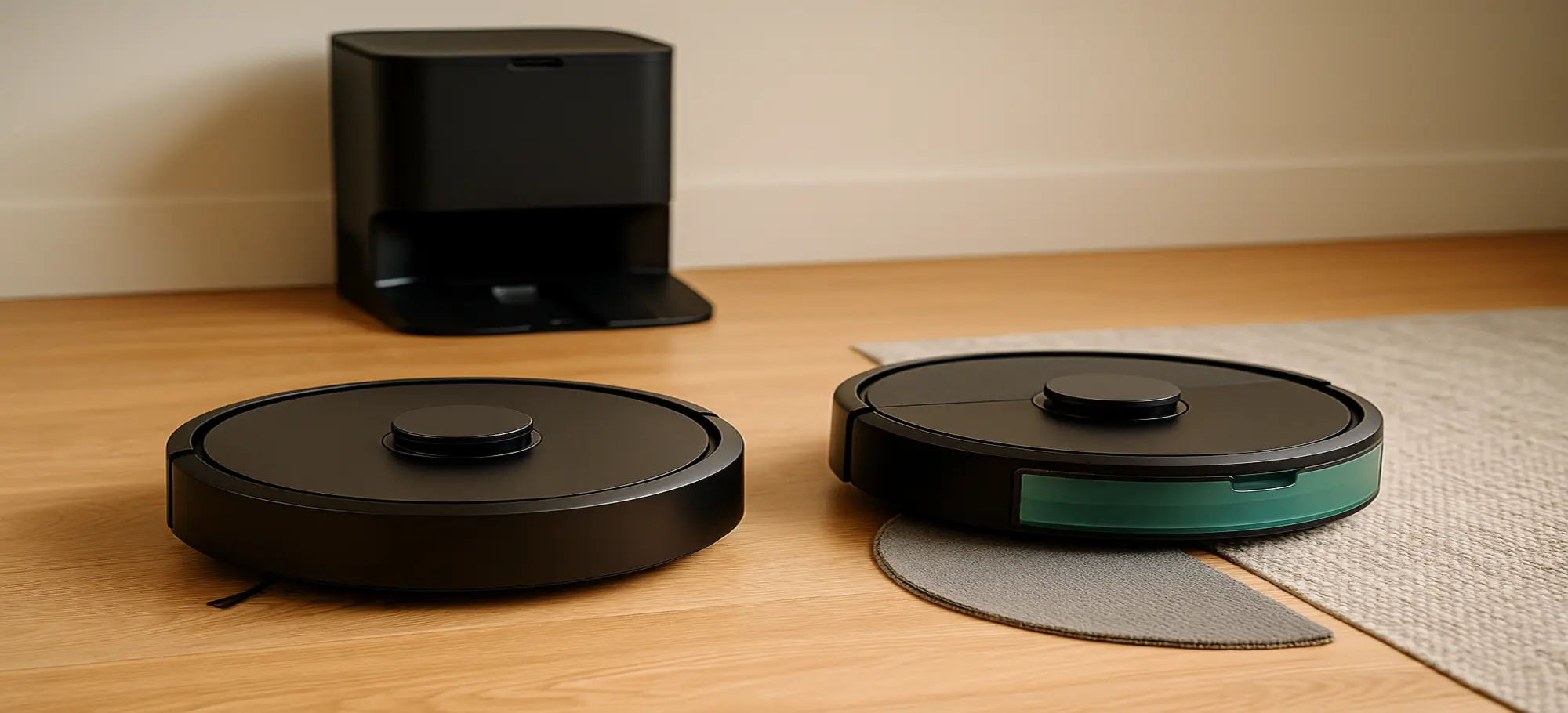
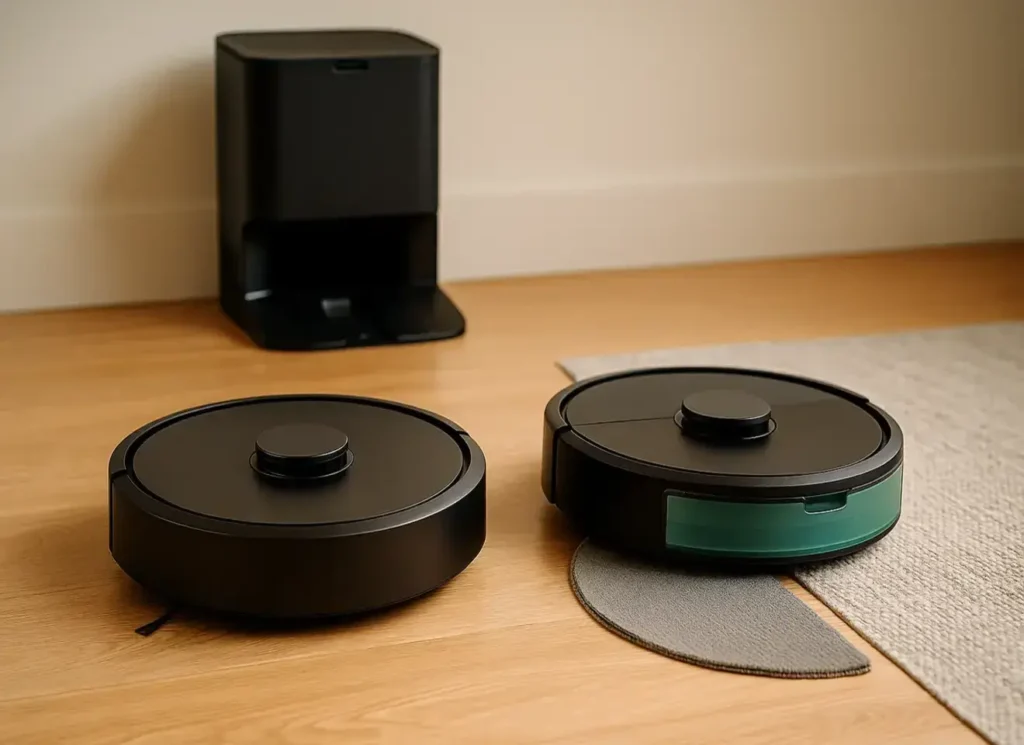
This image has been generated using AI for illustrative purposes only and does not represent an actual product image.
How They Stack Up Against the Competition
Inside iRobot’s ecosystem, the 100-series is the straightforward, budget-minded branch. You get the mapping behavior people expect from a modern robot without stepping into higher-tier pricing. If you later discover you need stronger carpet agitation or more advanced obstacle handling, stepping up within the lineup becomes sensible—but many homes won’t need to if AutoEmpty convenience or Combo mopping were the real missing pieces.
When a Different Tier Makes Sense
Mostly thick carpet: higher tiers often add better brush systems and more power delivery.
Obstacle-dense spaces: advanced avoidance prevents tangled sessions and protects tripods, toys, and cable nests.
All hard floors: Combo mopping keeps dust film down between manual passes and makes daily resets feel finished.
Price & Availability in 2025
Lineups and bundles change with seasons and promos. The Roomba 104 is presented as a Vac (charge-only) SKU, while the Roomba 105 family appears in multiple configurations (Vac, Combo, and AutoEmpty bundles). For current packages and what’s in the box, review the official Roomba 104 specifications and the iRobot Combo lineup. Additional note on timing: seasonal discounts tend to rotate between single-unit markdowns and bundle offers. If you’re on the fence between 104 and 105, watch a full week of price cycles—bundle math sometimes makes the 105 the better value even if the list price is higher. Inventory and regional packages can vary, so always double-check included accessories (dock type, spare filters, extra pads) before you buy.
Pros and Cons You’ll Actually Notice
Roomba 104 — Pros
Lowest-cost entry into this mapping generation.
Fewer parts to manage (vacuum-only).
Predictable, tidy routes after the first mapping week.
Simple ownership habits: empty bin, tap filter, check brush.
Easy to recommend for small to mid-size homes on a budget.
Minimal learning curve—“press clean” and go.
Roomba 104 — Cons
No mopping option.
No AutoEmpty bundle on the charge-only SKU.
Limited “buy-and-forget” convenience out of the box.
Not tuned for plush, high-pile carpets.
Fewer configuration choices if your needs change.
Roomba 105 — Pros
Flexible configurations (Vac or Combo) and AutoEmpty bundles.
Same mapping approach for consistent coverage.
Easier to “buy once” and adjust later.
Strong day-to-day convenience if you run the robot frequently.
Clear upgrade path without changing families.
Works well as a “household default” robot across mixed floors.
Roomba 105 — Cons
Higher spend if you add Combo or AutoEmpty.
More upkeep if you go Combo (pad + water).
Still an entry family—thicker carpets may need multiple passes.
Bundles can be confusing; always check what’s included.
Convenience features don’t replace routine brush/filter care.
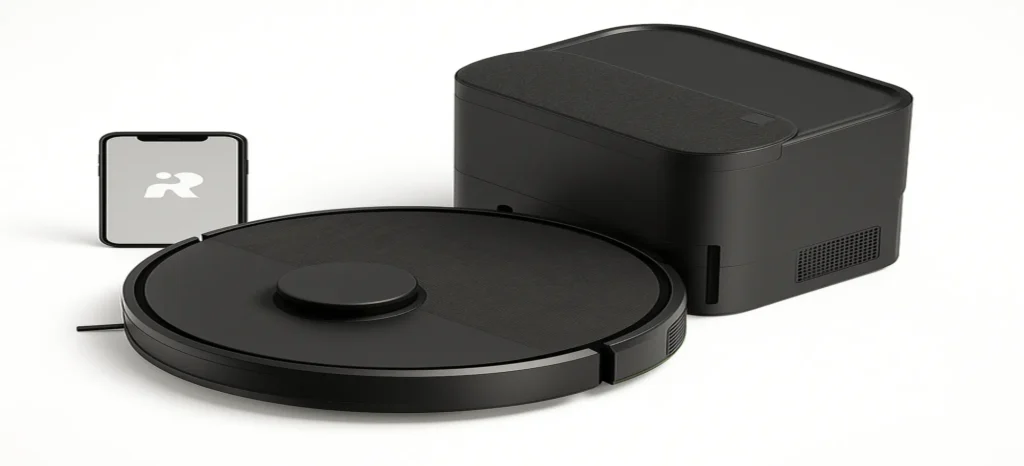
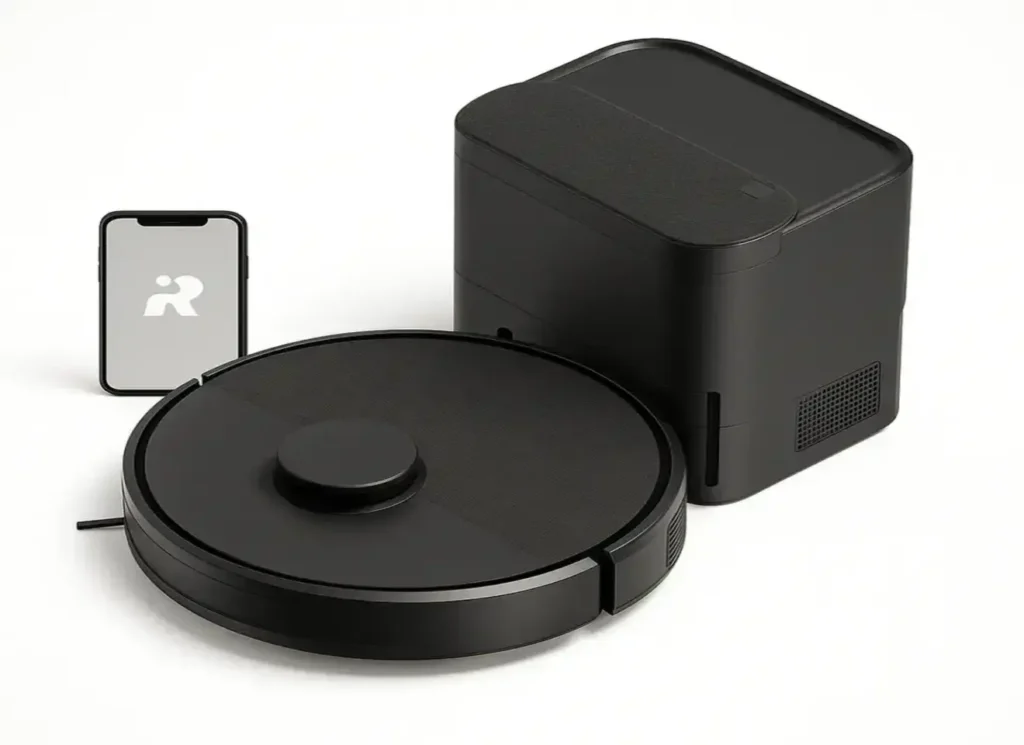
This image has been generated using AI for illustrative purposes only and does not represent an actual product image.
FAQ
Is Roomba 104 the same as 105?
No. 104 is a vacuum-only, charge-only SKU; 105 spans Vac and Combo variants and offers AutoEmpty bundles.
Which is better for pet hair: 104 or 105?
105 is the safer pick if shedding is heavy—AutoEmpty bundles cut bin chores, and the broader lineup lets you tailor routines for mixed floors.
Do both support smart mapping?
Yes. This series brings systematic routes and room naming in the app, so you can target rooms without a full-home run.
Can I add AutoEmpty later?
You can buy a 105 in an AutoEmpty bundle from the start or begin with a Vac configuration and move later. The 104 charge-only SKU is not sold with AutoEmpty.
Do either handle thick rugs well?
They’re tuned for hard floors and low-pile rugs. For plush carpets, plan extra passes—or consider stepping up in the lineup once you know your priorities.
Is the Combo mop worth it?
If most of your floors are sealed surfaces, 105 Combo keeps dust film and light footprints in check after a vacuum pass. If rugs dominate, stick to Vac and save money.
How noisy are they during calls?
You’ll hear them in the same room, but scheduled runs when you’re out or in another room make noise a non-issue. Short, targeted cleans help too.
How much maintenance do they really need?
A few minutes a week. Empty the bin, tap the filter, and check the main brush for hair. AutoEmpty bundles on the 105 reduce how often you handle the bin.
What’s the fastest way to improve results on day one?
Place the dock with a clear lane, tidy cable nests, and run two mapping passes before you start naming rooms. Results jump quickly once the map stabilizes.
Are accessories interchangeable between 104 and 105?
Basic consumables like filters and brushes often share form factors within a series, but always verify part numbers to avoid mismatches.
Final Verdict — One Clear Recommendation
If you want the lowest spend with modern mapping, choose Roomba 104 and keep it simple. If you want less maintenance and more flexibility, choose Roomba 105—Vac today, or go Combo and/or AutoEmpty now. Both deliver the predictable, row-by-row behavior that turns daily cleaning into a routine, not a chore.
Want to dive deeper into each model? Read the full Roomba 104 review and the complete Roomba 105 review for setup details, app tips, and long-term care notes.
Explore More
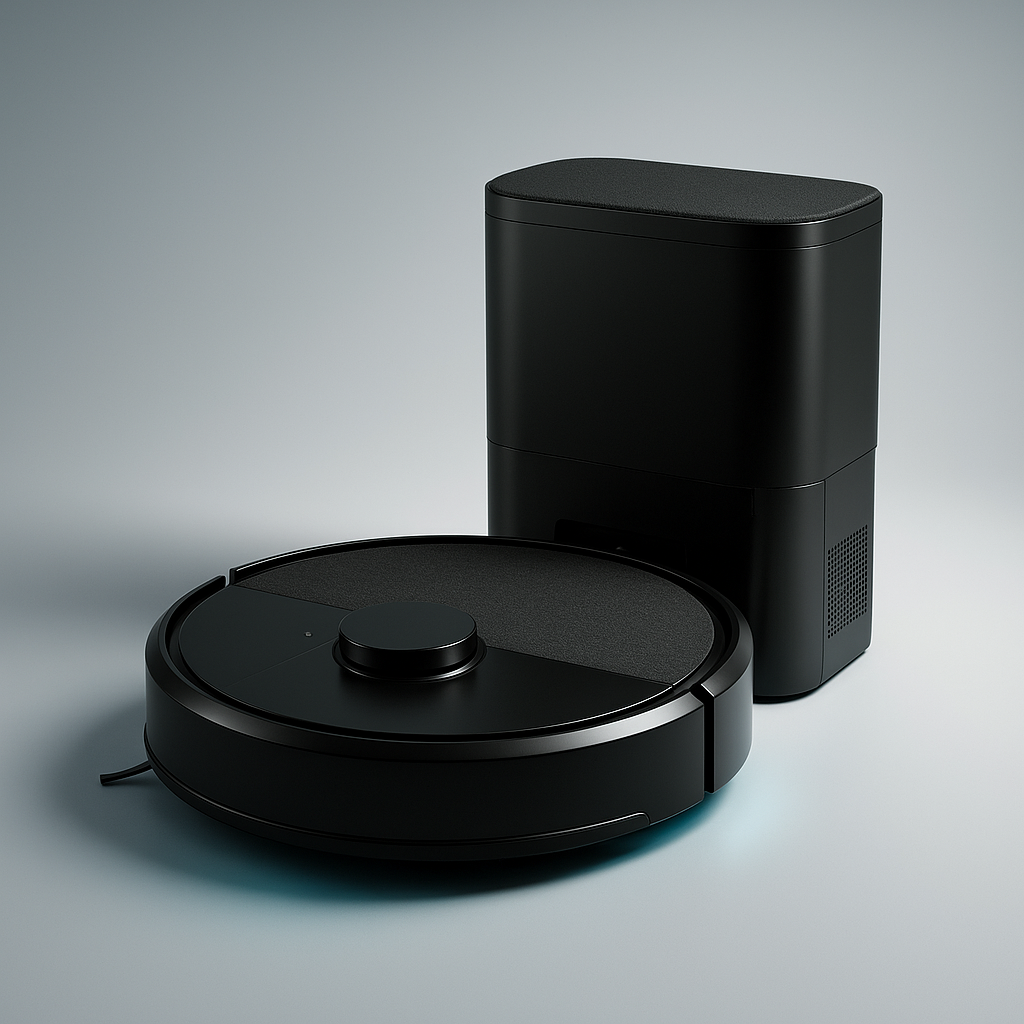
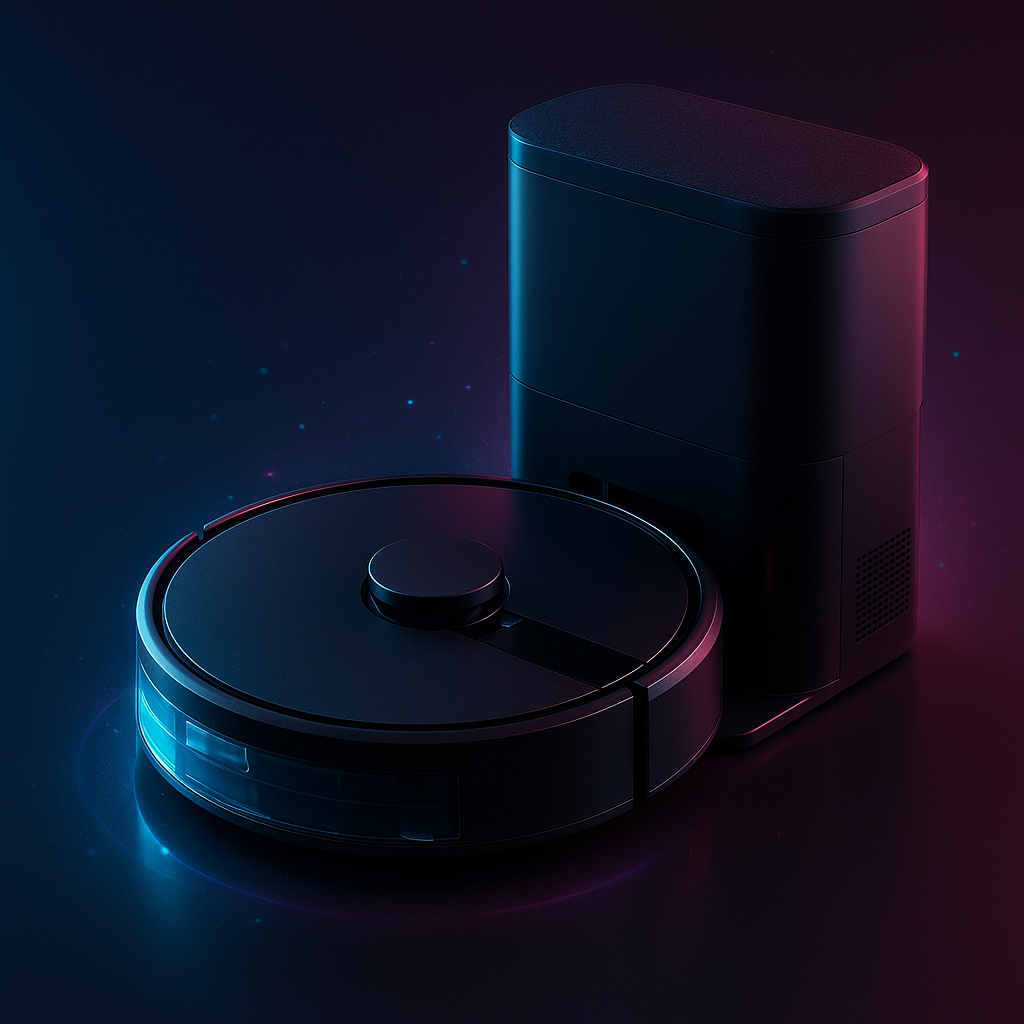

Related posts:
- Roomba 105 vs Roborock Q5: The Real Differences (2025) by EasySmartHomeGuide Editorial Team — Updated 8 October, 2025 Roomba...
- Roomba 105 Guide: From Unboxing to First Clean Roomba 105 Guide: From Unboxing to First Clean by EasySmartHomeGuide...
- iRobot Roomba 104 Robot Vacuum & Mop: The Ultimate Set-It-and-Forget-It Cleaner? Roomba 104 Robot Vacuum & Mop: The Ultimate Set It...
- Smart Thermostat Energy Saving Tips That Actually Help You Save by EasySmartHomeGuide Editorial Team — Updated 1 September, 2025 Smart...

